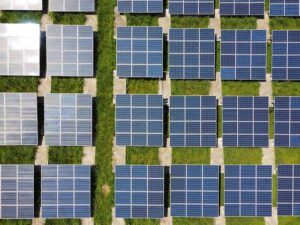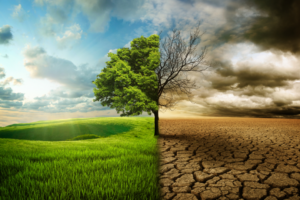The increasing ferociousness of weather extremes will wreak havoc on society
Not a day went by in 2022 where there wasn’t some mention of a weather extreme wreaking havoc on a community or country. This was no coincidence. Climate change is leading to more extreme weather events such as heatwaves, droughts, intense precipitation, and floods. These events can cause humanitarian disasters, destabilise markets, damage critical infrastructure, and harm food production. But 2022 was just a taste of what’s to come because we are well and truly hurtling into a world inundated by climate catastrophes.
A heatwave of unprecedented ferocity engulfed the world in the summer of 2022. China experienced the worst heat wave ever recorded, with temperatures soaring to over 45°C in Chongqing. The heatwave led to power shortages that paralysed industry and impacted economic output. On the West coast of the US, temperatures in California’s state capital of Sacramento reached 47°C. While in Europe, heat records were shattered, and the continent experienced its driest summer for five hundred years.
By 2100, heatwaves that currently have less than a 5 per cent chance of occurring in a year will occur almost every year. The regularity and increased ferociousness of heatwaves will mean 40°C weather in a country like England, known for having a temperate climate, will seem cool by the end of the century.
Record heat waves are turning the world’s rivers, canals, and reservoirs to dust. The Yangtze River in China, the Colorado River in the US, and the Rhine River in Germany all ran dry in the summer of 2022. These waterways are vital sources of drinking water, trade, and livelihoods. The Yangtze River, for example, provides drinking water for 400 million people and is vital for China’s economy.
As droughts become more severe, water scarcity will become all too common. In the early to mid-2010s, 1.9 billion people, or 27% of the global population, lived in areas that were at risk from severe water scarcity. In 2050, this number will increase to between 2.7 to 3.2 billion people. A report by the World Bank, High and Dry, shows how water scarcity, exacerbated by climate change, could impact economic growth, increase migration, and spark conflict.
While many regions suffered intense droughts, others experienced extreme precipitation and flooding. South Korea saw 381.5mm of rainfall in a day, the highest level of precipitation ever recorded. That biblical downpour led to destructive flash flooding in Seoul. Pakistan suffered devastating flooding after extreme monsoon rains, leaving one-third of the country underwater. This tragedy is symptomatic of a chronic injustice at the heart of the climate crisis. Developing nations that have contributed least to greenhouse gas emissions often have geographies that make them far more vulnerable to climate change.
In its Ecological Threat Report (ETR), the Institute for Economics and Peace highlights that 30 countries, home to 1.26 billion people, face the highest level of ecological threat. The major risk is that “ecological threats are correlated with high levels of violence. This is due to systemic dynamics, whereby the depletion of resources and violent disputes reinforce one another, forming a vicious cycle.” The lack of resilience in countries covered in the ETR will worsen food insecurity and competition over resources, increase civil unrest and mass displacement, and expose developed countries to increased influxes of refugees. Due to these risks, it’s estimated that by 2050 there will be one billion climate refugees, creating a humanitarian crisis on an unimaginable scale.
Perhaps the most debilitating impact of a changing climate will be on food production. The US, China, Brazil, and Argentina account for 87 per cent of the world’s maize exports. Between 2012–2017 global maize exports were 125 million tonnes, and total maize production was 986 million tonnes. With 2°C of global warming, total production in the top four maize-exporting countries is projected to decline by 53 million tons, equivalent to 43 per cent of global maize export volume. 4°C of warming will see production declines in these top-exporting countries increase to 139 million tons, which is 14 per cent of global production and exceeds present-day exports.
Chatham House’s Climate Change Risk Assessment shows how unstable grain markets are set to become. By 2040 the probability of a 10 per cent yield loss, or greater, within these four countries rises to 40–70 per cent. The probability of a synchronous, greater than 10 per cent crop failure across each country at the same time is currently near zero, but “the probability of a synchronous crop failure of this order during the decade of the 2040s is just less than 50 per cent.” The report goes on to suggest that “multiple breadbaskets may suffer simultaneous effects, with the potential to drive a significant reduction in yields at global as well as regional levels.”
The 2006–2008 global food crisis illustrates the potential consequences of synchronous crop failures. Price spikes can lead to urban unrest and make governments vulnerable to collapse, particularly in developing countries. Due to this risk, many large exporting countries, including Brazil and Argentina, imposed export bans on maize during the food crisis, decreasing global supply. At the same time, maize-importing countries introduced trade incentives to lower the price of imported grain, increasing import demand. The combination of less supply and more demand led to maize prices spiking by 83 per cent. It was a similar story for other staple grains like rice and wheat.
The consequences of mass crop failures will be seismic. Since the end of the second world war, massive productivity gains combined with the distributive power of the free market triggered the Great Acceleration, a historical anomaly leading to an explosion of human activity. This period of unprecedented economic growth transformed the world from scarcity to abundance. Arguably the most transformative aspect of this shift is with food prices. The cost of food, which had made up as much as 75 per cent of wages in wealthy nations well into the nineteenth century, has plummeted to just a few per cent of wages in modern society.
Abundance has made it mutually beneficial to join an increasingly interconnected world economy and sell products and produce to one another. This is a significant reason why peace has followed in the footsteps of globalisation. The benefits of peace far outweigh the price of war. But if mass droughts create food shortages, cooperation will likely break down as grain-producing countries will become more protectionist and ban exports to maintain social stability. Not only that, but exporting countries may use food as a weapon that they can use to leverage power and influence. With chronic shortages, “a societal consensus could emerge that the free market economic model is unsustainable, and governments could move towards constraining people’s consumption…this could lead to macro-economic discontinuities with far-reaching consequences for inflation rates, asset prices, jobs, and livelihoods.”
Our lives have always been defined by a basic social expectation of the freedom to choose what you say, do and buy. Having more money and possessions than others is considered key to social success. Governments encourage increasing consumption because it’s so important for a thriving economy, and companies depend on it to maintain profit margins. The idea that our consumption habits would need to be constrained will feel like a draconian measure when life has always been defined by a celebration of consumption. Governments will be all too aware that such extreme measures will be deeply unpopular and are likely to trigger social unrest, but they’ll be faced with no other choice.
Globalisation can only work if every country is willing to sell on the open market, but as the impacts of the climate crisis become more aggressive and scarcity begins to impact prices, those days will come to an end. Seeing as growth is key to averting an economic crisis, a return to scarcity could lead to a global economic depression, resulting in mass job losses and a sharp decrease in living standards, which will only work to further erode confidence in the ability of governments to maintain stability.
Food shortages, water scarcity, climate refugees, a breakdown of cooperation in the market, economic shocks, inflation — and this is just touching the surface. When you combine the impacts of environmental changes, they are set to increase “the level of stress within national and international society, thus increasing the likelihood of many different kinds of conflict and impeding the development of cooperative solutions.” In a world of scarcity, the risk of war, including nuclear war, will increase as countries seek to gain control of critical resources. Ultimately environmental changes could “cause the gradual impoverishment of societies…which could aggravate class and ethnic cleavages, undermine liberal regimes, and spawn insurgencies.”
This is the ultimate risk. The breakdown of the market system would create so many points of vulnerability at various levels of society that it precipitates social breakdown on a global scale. The rules of the game and the norms and values that provide clarity, certainty, and stability will break down. Whatever way you look at it, the scale of environmental changes means social transformation has become inevitable; what’s not is what that transformation will look like.



